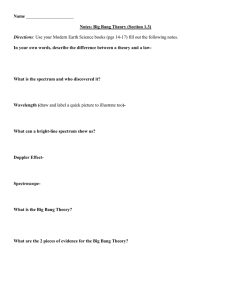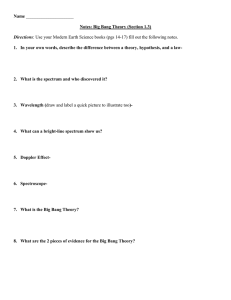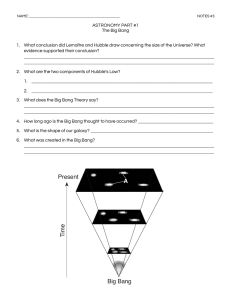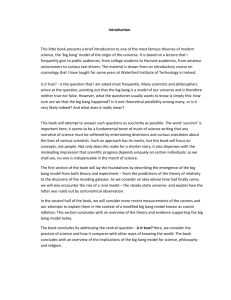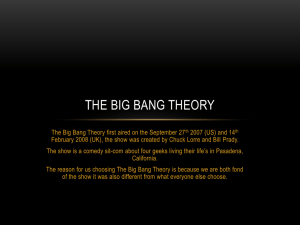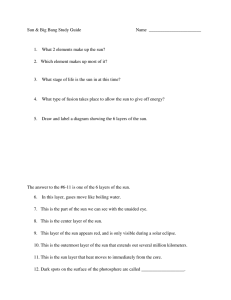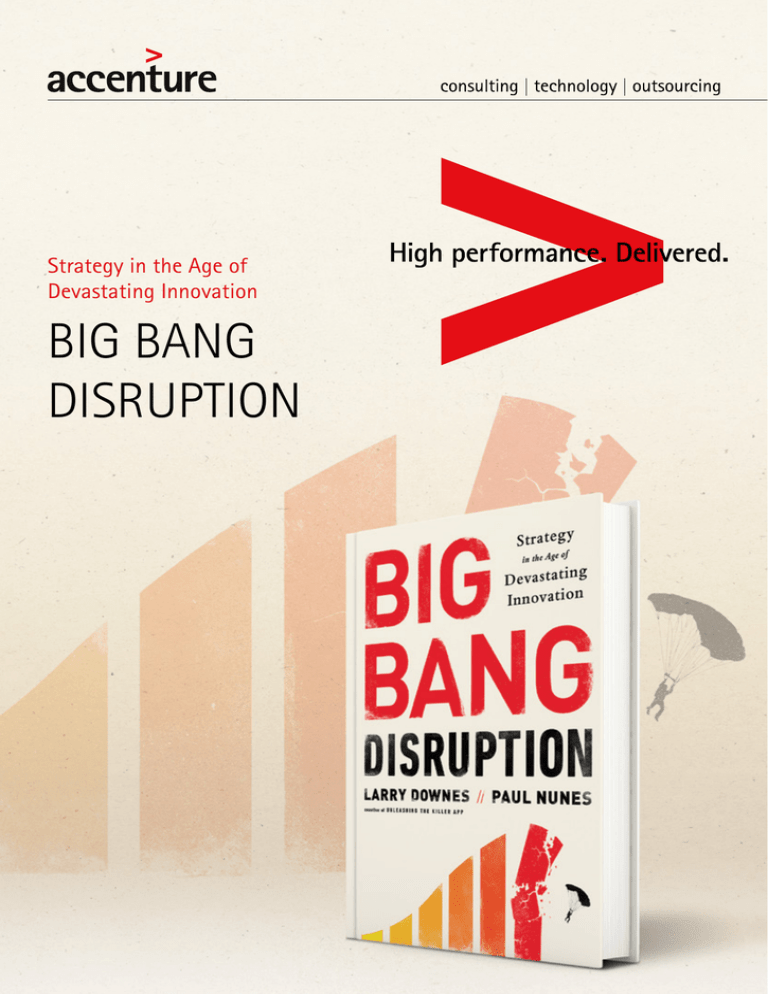
Strategy in the Age of
Devastating Innovation
BIG BANG
DISRUPTION
It used to take years or even decades for disruptive
innovations to displace dominant products and services
and destabilize incumbent industries. Now any business
can be devastated virtually overnight by something
better AND cheaper.
HOW CAN EXECUTIVES
PROTECT THEIR
BUSINESS AND LEARN
TO HARNESS THE
POWER OF BIG BANG
DISRUPTION?
1
Just a few years ago, drivers happily
spent more than $200 for a GPS
unit. But as smartphones exploded
in popularity, free navigation apps
exceeded the performance of
standalone devices. Eighteen months
after the debut of the navigation tools,
leading GPS manufacturers had lost
85 percent of their market value.
Consumer electronics and computer
makers have long struggled in ultracompetitive markets where exponential
technology improvements mean
even the newest products often
have short lives. But until recently,
hotels, taxi services, doctors and
energy companies had little to fear
from the information revolution.
Those days are gone forever. It’s now the
age of Big Bang Disruption, where every
business is a digital business. Software
products are replacing physical goods.
And every service provider must
compete with cloud-based tools that
offer customers a better way to interact.
Today, startups with minimal experience
and no capital can unravel your
strategy before you even begin to
grasp what’s happening. Never mind
the “innovator’s dilemma”—this is
the innovator’s disaster. And it’s
happening in nearly every industry.
Worse, Big Bang Disruptors may not even
see you as competition. They don’t share
your approach to customer service, and
they’re not sizing up your product line
to offer better prices. You may simply
be collateral damage in their efforts
to win completely different markets.
But any business can master the
strategy of the startups. Larry Downes
and Paul Nunes analyze the origins,
economics and anatomy of Big Bang
Disruption. They identify four key stages
in the new innovation lifecycle, helping
you spot potential disruptors in time.
And they offer 12 rules for defending
your markets, launching disruptors of
your own, and getting out while there’s
still time—and profit.
Based on extensive research by
the Accenture Institute for High
Performance and in-depth interviews
with entrepreneurs, investors, and
executives from more than 30
industries, Big Bang Disruption will
arm you with strategies and insights
to thrive in this brave new world.
Big Bang Innovation happens
in four stages, named for the
corresponding periods of the
Big Bang theory of the universe,
in which matter and energy
were created suddenly and then
dissipates slowly over a long
period of time. Given its shape,
we call this new lifecycle for
innovation “The Shark Fin”.
The Shark Fin
The Singularity
The Big Bang The Big Crunch
Entropy
2
PART 1:
BIG BANG DISRUPTION
CHAPTER 1: What Is Big
Bang Disruption?
CHAPTER 2: The Economics
of Big Bang Disruption
Big Bang Disruption is a dramatic new
kind of innovation. Instead of entering
the market as a product that is either
inferior to or more expensive than
those of established incumbents, a
Big Bang Disruptor is both better and
cheaper from the moment of creation.
Using new technologies including
broadband networks, cloud-based
computing and increasingly powerful
and ubiquitous mobile devices, Big
Bang Disruptors can destabilize mature
industries in record time, leaving
incumbents and their supply-chain
partners dazed and devastated.
How are Big Bang Disruptors
transforming the lives of consumers,
redefining transactions that may not
have changed much since the Industrial
Revolution? And why, after decades of
computerization and other technological
innovation, are disruptors suddenly
arriving with such alarming frequency?
The accelerating pace of Big Bang
Disruption is driven by core technologies
that become better and cheaper with
each iteration. The most familiar of
these “exponential technologies”
is the computer processor, which,
according to the formulation known
as Moore’s Law, continually becomes
faster, cheaper, and smaller. But a new
generation of exponential technologies
in fields as diverse as chemistry,
optics, materials, and energy promises
to undermine industries for decades
to come. Capitalism’s “perennial
gales of creative destruction” are
now Category Five hurricanes.
The Declining Cost of Creation
3
The short answer is that the continued
application of exponential technologies
has created a series of transformative
changes in market economies. They are
simultaneously driving down the three
core costs of products and services:
Steep declines in the cost of key
raw materials, including computer
hardware and software, along with
increasingly efficient supply chains,
empowers innovators large and small
to compete on all three traditional
strategic dimensions at once:
products and services can begin life
with higher quality, at a lower price
and more easily customized that
those of traditional competitors.
The Declining Cost of Information
As social networks, microblogging, and
independent review services proliferate,
consumers now have easy access to nearperfect market information. Successful
product and service experiments
can be discovered and adopted
instantaneously by customers across
every traditional segment. Innovators
no longer need to cultivate “early
adopters” to establish new markets.
The Declining Cost of
Experimentation
Thanks to global broadband networks and
ubiquitous computing devices, innovators
and users can now be connected in an
environment optimized for collaboration.
New products and services often begin
life as simple combinations of existing
components, tested with little cost or
risk directly in the market with real
consumers. Compared to traditional
proprietary R&D, the “cost of combine”
increasingly beats the “cost of design.”
CHAPTER 3: The Shark Fin
Big Bang Disruptors come and go
in relatively short blasts of market
penetration and market saturation. The
longstanding bell curve of technology
adoption first proposed by Everett Rogers
now appears placid and predictable by
comparison. When Big Bang Disruptors
take off, they do so quickly, rising and
falling less like a curve and more like a
shark’s fin. Where traditional technology
marketing moves through five distinct
market segments, Big Bang Disruption has
only two—trial users and everybody else.
Big Bang Disruption begins with
a series of seemingly random
experiments, as innovators work with
different combinations of component
technologies and business models. Most
experiments fail, giving incumbents the
false sense that disruption is still far off.
Yet, when the right combination of
technologies is combined with the right
business model, take-off is immediate.
Customers adopt the disruptor as
quickly as its producers can supply
it. Market penetration is often nearly
instantaneous. For software-based
products, innovators may sign up
millions of users in a matter of days.
Then, as the disruptor quickly approaches
saturation, adoption drops at nearly the
same pace with which it took off, leading
to a period of rapid if uneven decline.
CASE IN POINT: Microsoft’s Kinect, an
add-on to the company’s Xbox 360 that
brought voice and motion activation
to high-end home game consoles,
introduced sensing technologies
far from gaming. Some, in fact,
came from military applications.
The result was a revolution in video
gaming that looked less like its
immediate predecessors and more
like a technology from the future.
Perhaps the real precursor for Kinect
was the computer interface used
by Tom Cruise in a famous scene
from the futuristic movie “Minority
Report,” where projected displays
of data were manipulated by hand
motions that simulated swiping,
grabbing, and dropping virtual items.
Kinect was an enormous hit, selling 8
million units in just the first 60 days.
A little over a year after launch, 24
million Kinects had been sold, pushing
sales of Xbox 360 consoles and games
along with it. Though stragglers
would continue to buy the Kinect in
peaks and valleys over the next year,
the product had largely fulfilled its
mission in its first 10 months. For
Microsoft—and other game developers—
it was time for another innovation.
Big Bang Disruption Upends Conventional Wisdom
CONVENTIONAL WISDOM
BIG BANG WISDOM
Focus on only one strategic “discipline”
or “generic strategy” - low cost,
premium product, or customer intimacy.
Compete on all three strategic
dimensions at once. Enter the market
better, cheaper and customized;
innovate constantly.
Strategy
First target a small group of early
adopters and later enter the
mainstream market.
Market to all customer segments
immediately, and be ready to scale
up and then exit - swiftly.
Marketing
Seek innovation in lower-cost, featurepoor technologies that meet the needs
of underserved customer segments.
Innovation
Launch low-cost experiments directly
in the market. Combine reusable
components rather than designing
from scratch.
4
Big Bang Disruption collapses
Everett Rogers’s classic bell
curve of five distinct customer
segments—innovators, early
adopters, early majority, late
majority, and laggards. Now
there are only two groups: trial
users, who often participate
in product development, and
everybody else. Once the right
combination of technologies
and business model come
together in a successful market
experiment, mainstream
consumers move en masse
to the winner. The adoption
curve has become something
closer to a straight line that
shoots up, and then falls rapidly
when saturation is reached
or a new disruptor appears.
Big Bang Market Adoption
BIG BANG MARKET
SEGMENTS
Trial
Users
Innovators
Everybody
Else
Early Adopters
Early Majority
ROGERS’S MARKET SEGMENTS
5
Late Majority
Laggards
PART 2:
STRATEGY IN THE
AGE OF DEVASTATING
INNOVATION
CHAPTER 4: The Singularity
The Singularity is the primordial ooze
from which Big Bang Disruptors emerge.
It is populated by weird experiments and
often weirder experimenters, who fling
together seemingly bizarre combinations
of off-the-shelf parts and loosely
connected service providers to launch
new enterprises without a business
model, let alone carefully crafted
strategic plans with paths to profitability.
They collaborate on design, testing,
and even funding with customers. Not
their customers—your customers.
This is the home of unencumbered
development, where time to market
now exceeds time in market. Right
now, disruptors of all kinds are
brewing, driven by programming
“hackathons,” open source components,
and venture-backed incubators. Their
developers, increasingly financed by
early users, sift through crowdsourced
modifications and implement them
directly into their products.
Because experimentation has become
so cheap and the risk of failure so
low, it’s very likely that some market
experiments aimed at the heart
of your business are running right
now. Most will fail. But it only takes
one to devastate your business.
CASE IN POINT: MakerBot, a leader
in the emerging 3D printing industry,
emerged from the growing community
of do-it-yourself innovators who
raise money for their projects on
crowdfunding sites such as Kickstarter
and share their designs using open
source protocols. MakerBot was
founded by a former school teacher
with tinkerers he met at a hackathon.
They recognized that off-the-shelf
components were readily available
to assemble a low-cost home 3D
printer years before traditional
industrial prototype manufacturers
were ready to enter the market.
CHAPTER 5: The Big Bang
The Singularity, the wild period of failed
early market experiments, signals the
imminent arrival of true disruption. When
the Big Bang comes, everything is sudden,
including success and failure. Customers
either arrive at once or not at all.
Big Bang markets are by their nature
“winner take all.” In this stage of the
shark fin, time seems to move at an
accelerated pace—for entrepreneurs,
Twelve Rules for Big Bang Disruption
THE SINGULARITY
1. Consult your truth-tellers
2. Pinpoint your market entry
3. Launch seemingly random experiments
THE BIG BANG
4. Survive
catastrophic
success
5. Capture winnertake-all markets
6. Create bullet
time
THE BIG CRUNCH
ENTROPY
7. Anticipate saturation 10. Escape your own
black hole
8. Shed assets before
they become liabilities 11. Become someone
else’s components
9. Quit while you’re
ahead
12. Move to a new
singularity
6
their customers, and most of all for
incumbents who may wake up one
morning to find their core products
and technologies displaced by
something better and cheaper.
Because Big Bang Disruptors are
driven by near-perfect market
information, new products and services
spread virally. Customers generate
extreme market demand even as they
continuously rewrite the business case
for the disrupter. Innovators, whether
start-up or incumbent, must learn to
see the signs of ”catastrophic success,”
and develop skills to survive the rapid
acceleration that accompanies it.
CASE IN POINT: Even companies whose
service is entirely digital can experience
growing pains when catastrophic
success arrives. Consider Twitter, which
famously began its commercial life as
an experiment launched during a tech
conference in 2007. Five years later,
the company boasted over 200 million
users. Even the most cockeyed optimist
couldn’t predict that kind of growth, and
in early years the company struggled
with a technical architecture that didn’t
scale fast enough. Investors quickly
brought in seasoned management. The
newly-public company’s deceptively
simple user interface is now backed
up by nearly 1,000 engineers. And
a market cap of $22 billion.
CHAPTER 6: The Big Crunch
Success in winner-take-all markets can
be dangerously deceptive. Innovators
believe themselves invincible, even
as competitors quickly imitate their
best ideas. Innovators quickly turn
into incumbents, more concerned
about preserving market share than in
anticipating what consumers want next.
Growth stalls; revenue declines.
That’s the trap that characterizes
the Big Crunch. While the Big Bang
stage is filled with excitement and
exuberance, the Big Crunch is the
sober morning after. It is the most
dangerous stage of the shark fin.
In the Big Crunch, start-ups and
incumbents alike are frequently caught
unprepared for the rapid market
saturation that occurs when nearperfect market information brings every
interested customer to their door all
at once, to be quickly served either by
them or aggressive imitators.
7
In their exuberance, they often
overlook the unpredictable tastes of
increasingly faddish consumers, whose
preferences can shift overnight in the
opposite direction. With the arrival
of a better and cheaper alternative,
abandonment can be spontaneous,
even immediate. Markets that once
took years and even decades to
saturate can now reach their natural
capacity in months or even weeks.
When the Big Crunch comes, markets
contract, pulling down start-ups and
incumbents alike.
For those who manage to soldier on,
strategy shifts dramatically. Here it’s
all about survival of the fastest—the
fastest to recognize impending market
saturation, the fastest to scale down,
and the fastest to shed assets that are
soon to become liabilities.
The winners are invariably companies
that know how to temper Big Bang
success with the pragmatic reality that
the party can’t and won’t last long.
CASE IN POINT: Philips Lighting
has been a pioneer and leader in
incandescent bulbs for over a century.
Yet in 2006, the company announced
the end was near for its core product
and the source of much of the profits
for its parent company, industrial giant
Philips. But exponential improvements
in energy-efficient LEDs made it clear to
management: the end was only a matter
of time. By working with governments
and NGOs to mandate the retirement
of incandescents, Philips ensured its
competitors would need to go through
the same wrenching transformation—on
a timetable set by Philips. Meanwhile,
the company initiated a full-scale
assault on the future market.
CHAPTER 7: Entropy
By the end of the Big Crunch,
customers have abandoned the old
industry and migrated en masse to
the new. Most incumbents leave the
dying industry and its supply chain,
taking with them whichever of their
inventories, assets, and intellectual
property have retained value in the
new ecosystem and selling, as quickly
as they can, those that do not. Some
old enterprises find profitable homes
in the new world; some pivot to other
industries. And some simply disappear.
The final stage of Big Bang Disruption is
Entropy, where the matter and energy of
the old industry are so dissipated they
are barely capable of productive work—
if at all.
In Entropy, a few stragglers often
remain, electing to serve a small
but consolidated group of legacy
customers who can’t or won’t adopt
better and cheaper products, and who,
for whatever reason, are content to
remain with goods—pocket calendars,
home telephones, cash registers—that
are worse and more expensive, if only
because they are more familiar.
By carefully managing costs, legacy
providers can thrive in Entropy, or at
least find ways to manage a profit. For
the rest, there’s still a chance to salvage
remaining assets, and to make a delayed
but life-saving exit.
CASE IN POINT: For electronics giant
Texas Instruments, the decline of its
home computer business in the early
1980s was sudden enough to put the
company in serious jeopardy. As TI shut
down its consumer products business, a
single part in a single product became
the source of a dramatic resurrection.
Inside the Speak & Spell, a children’s toy,
the company’s pioneering digital signal
processor proved to be a component
part flexible enough to translate analog
to digital signals in everything from
weather systems to smartphones. DSPs
still represent $2 billion in annual
revenue for TI. But more important,
the company found a comfortable
new home for itself as the provider of
parts to other manufacturers—an arms
merchant rather than a combatant in
volatile electronics markets.
THE THREE
CHARACTERISTICS
OF A BIG BANG
DISRUPTOR
Big Bang Disruption is different not just in speed but in kind
from traditional forms of innovation. It is defined by three unique
characteristics that drive radical new approaches to strategy,
marketing, and product development. Together, these features
of Big Bang Disruption create new ecosystems, more adaptable
and resilient to future disruption than older supply chains.
1
2
3
Undisciplined Strategy
Unconstrained Growth
Unencumbered Development
Thanks to exponential technologies,
Big Bang Disruptors enter the market
simultaneously better and cheaper, and
more customized than the products and
services of incumbents. Yet decades
of academic thinking on strategic
planning warned businesses to focus
on only one “market discipline”— to
compete on cost, differentiation, or
customization. Big Bang Disruptors
are thoroughly undisciplined.
When Big Bang Disruptors arrive, the
slope of market adoption is nearly
vertical. Big Bang markets exhibit
winner-take-all results and short
product lives. So there’s little point to
carefully timed marketing campaigns
addressed to different customer groups
over a controlled product release.
Instead of paying a premium price,
today’s early adopters now expect to be
part of product design, marketing, and
even ownership.
Big Bang Disruptors are often little
more than the combination of off-theshelf components, parts and software,
launched as a series of low-cost
experiments supported, when necessary,
by third-party infrastructure partners.
These product tests are carried out
directly in the market, with real users
serving as collaborators. A Big Bang
Disruption is simply an experiment that
goes very well.
8
TWELVE RULES FOR
BIG BANG DISRUPTION
THE SINGULARITY
5. Capture winner-take-all markets 9. Quit while you’re ahead
1. Consult your truth-tellers
Sacrifice everything, including shortterm profits, to ensure victory in
winner-take-all markets, especially
when success with one disruptor can
be leveraged into follow-on products
that can be created and launched
even faster than the original.
Find industry visionaries who see the
future more clearly than you do, and
who won’t sugarcoat it even when you
want them to.
2. Pinpoint your market entry
Learn to separate the little bumps from
the Big Bangs, choosing just the perfect
moment to enter a new ecosystem.
3. Launch seemingly
random experiments
Practice combinatorial innovation
directly in the market, collaborating with
suppliers, customers, and investors—who
may be one and the same.
THE BIG BANG
4. Survive catastrophic success
Prepare to scale up from experiment to
global brand in the space of months,
if not weeks, and to redesign your
technical and business architecture
even while running at full speed.
9
6. Create bullet time
Judiciously employ litigation and
legislation to slow the progress of
disruptors, even as you proceed with
your own experiments, partnerships,
and well-timed acquisitions.
THE BIG CRUNCH
7. Anticipate saturation
When consumers adopt and then
abandon new products and services all
at once, it’s essential not to be caught
with excess capacity or inventory.
8. Shed assets before they
become liabilities
Knowing the right time to sell, and
to whom, can mean the difference
between your ability to develop the
next disruptor and bankruptcy.
Courageous executives accept the
inevitable, and announce their exit
from current markets while they are
still strong.
ENTROPY
10. Escape your own black hole
Beware the deadly legacy of your
older products and services once
better and cheaper alternatives
are readily available.
11. Become someone
else’s components
As humbling as the idea may sound,
companies trapped in Entropy often find
their best hope is to shut down a retail
business and transform into a supplier of
parts and other resources for innovators
in ecosystems emerging elsewhere.
12. Move to a new singularity
Co-opt the tools of the disrupters
and their investors, and use them
to relocate your remaining assets
to a healthier ecosystem.
CONCLUSION
As exponential technologies and
the disruptors they spawn remake
your industry in ever-shorter
cycles, the most valuable asset
you can have is speed. You have
to be quick to spot the failed
early market experiments of the
Singularity, to survive catastrophic
success in the Big Bang, to
maximize the residual value of
declining assets in the Big Crunch,
and to abandon legacy customers
before you’re crushed by the
intense gravity of Entropy.
Few companies can operate for long
at the pace of exponential change,
but they don’t really have to. Recall
the old joke about two campers who
awake to hear a bear rummaging
around outside their tent. One of the
campers begins to put on his shoes.
“What are you doing?” the other asks
incredulously. “You can’t outrun a
bear.” “I don’t have to,” the first one
replies. “I just have to outrun you.”
How fast do you need to be to
outrun the other campers?
Here’s a good rule of thumb. The
companies that thrive in Big Bang
Disruption are those with the energy
to work at the pace of a young
entrepreneur pulling an all-nighter at a
hackathon, fueled by unrealistic hopes
and too much caffeine. So get ready—
and make sure you’re wearing your
running shoes.
10
ABOUT THE AUTHORS
Larry Downes is a Research Fellow
at the Accenture Institute for High
Performance, and an Internet industry
analyst focused on the impact of disruptive
technologies on business and public
policy. His first book, Unleashing the Killer
App, was one of the biggest business
bestsellers of the early 2000s. He is
a columnist for Forbes and CNET, and
writes regularly for other publications
including USA Today and the Harvard
Business Review. He lives in Berkeley, CA.
Paul Nunes is the Global Managing
Director of Research at the Accenture
Institute for High Performance, and the
Senior Contributing Editor at Outlook,
Accenture’s journal of thought leadership.
His most recent book is Jumping the
S-Curve. His research findings have
been covered by the New York Times,
Wall Street Journal, USA Today, and
Forbes. He is a frequent speaker at
industry conferences, and has served as
an invited speaker at many top business
schools. He lives in Boston, MA.
ABOUT THE ACCENTURE
INSTITUTE FOR HIGH
PERFORMANCE
The Accenture Institute for High
Performance develops and publishes
practical insights into critical management
issues and global economic trends. Its
worldwide team of researchers connects
with Accenture’s consulting, technology
and outsourcing leaders to demonstrate
how organizations become and remain
high performers through original, rigorous
research and analysis. Please visit us at
www.accenture.com/institute.
ABOUT ACCENTURE
Accenture is a global management
consulting, technology services and
outsourcing company, with approximately
275,000 people serving clients in
more than 120 countries. Combining
unparalleled experience, comprehensive
capabilities across all industries and
business functions, and extensive research
on the world’s most successful companies,
Accenture collaborates with clients to
help them become high-performance
businesses and governments. The company
generated net revenues of US$28.6 billion
for the fiscal year ended Aug. 31, 2013. Its
home page is www.accenture.com.
For more information:
Copyright © 2013 Accenture
All rights reserved.
Accenture, its logo, and
High Performance Delivered
are trademarks of Accenture.
13-3870

